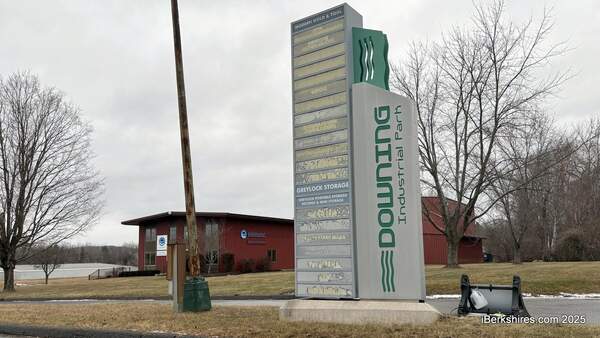Rattlesnakes: Disparaged Denizens of the Berkshires
 Once abundant timber rattlesnakes are disappearing from the Berkshires because of loss of habitat. Once abundant timber rattlesnakes are disappearing from the Berkshires because of loss of habitat. |
PITTSFIELD, Mass. — Colorful, venomous, and increasingly rare — rattlesnakes have had an interesting history among the residents of the Berkshire hills, one that has left its mark on the lives, literature, and general cultural psyche of its more recently arrived neighbors.
"No other snake in Western Massachusetts has the history, lore, fiction, and fascination as the timber rattlesnake," according to local naturalist Tom Tyning, who has spent many years studying these creatures.
These reptiles were found in comparative abundance when settlers first arrived throughout this part of New England, but over time have shrunk to a meager fraction of their previous numbers.
Historic loss of habitat is the single largest factor for this, according to Tyning, an environmental science professor at Berkshire Community College who has studied the timber rattlesnake for decades.
"Like all forest species, timber rattlesnake populations made a large decline in the mid 1800s throughout New England when 70-85 percent of our forests were clear-cut for farming," Tyning told iBerkshires.
When farming was largely abandoned, along with an iron industry that had also required large-scale deforestation, the forest returned along with some, but not all, of its previous inhabitants.
"Some, like beavers and turkeys were completely extirpated and had to be brought back by hand," said Tyning. "Others, like mountain lions and rattlesnakes were not allowed — most Northeastern states maintained bounties on them and organized hunts, even here in the Berkshires, sent men to kill rattlesnakes (and any other snake for that matter) in their remote locations."
In recent memory, the range of habitat of the timber rattlesnake (Crotalus horridus) in the region has basically been confined to south of Monument Mountain, but this was not always the case. Place names such as Rattlesnake Hill in Stockbridge and Williamstown's Rattlesnake Brook hint at an earlier era when these creatures enjoyed a greater presence to the north.
Harold O. Cook, who served as a state forester for 54 years, attests to coming across three while laying out the Appalachian Trail through Clarksburg State Forest near the Vermont line in 1925. Cook said he'd also spotted them on a road in Greylock Reservation.
Their further northern reach can also be seen in the history of towns throughout the southern parts of Vermont and New Hampshire, where bounty laws can be found on the books in early town records.
Once, these animals had been a source of great fear and considered a serious problem. Getting rid of rattlesnakes is listed as the first order of business at the first town meeting in Canaan, Conn., where town fathers made a point to declare a bounty on them even before planning their church.
It was once said that ladies (and some gentleman, I'm sure) would defer to get out of their cars in the town of Mount Washington, owing to that town's reputation for plentiful timber rattlers. Fears of rattlesnakes also cast a shadow of concern over the search for 18-year-old Earle Sutphen, who became lost in the woods in Sheffield in 1951.
Such fear was disproportionate to the actual risk posed by these native fauna. Raymond Ditmars, famed Bronx Zoo herpetologist who spent a great deal of time in the Berkshires, had heard of only three cases of bites by these snakes, all due to carelessness near known snake dens, and only one fatal. In total, records show two known fatalities in Western Massachusetts, dating from 1761 and 1860, respectively.
"Because the innocent snake was the villain of the Bible, he has always had a hard time in New England," wrote local artist and writer Morgan Bulkeley.
No doubt, a popular novel by one well-known author and summer resident, Oliver Wendell Holmes, did nothing to help the sinister reputation of the rattlesnakes.
 Not all timber rattlers have diamond backs. More information from the Natural Heritage Endangered Species Program can be found here. Not all timber rattlers have diamond backs. More information from the Natural Heritage Endangered Species Program can be found here. |
In what Holmes called his "medicated novel," "Elsie Venner," the author attempts what is perhaps the first study of a sociopathic personality, a condition of inherent "evil" which in the novel he attributes to a rattlesnake bite received by the mother of the title character while Elsie was still in the womb.
Once grown, Elsie exhibits various serpentine attributes, described as coiling, slithering, striking, and has "diamond eyes" and cold skin. Her only friends are snakes.
The novel takes place in the fictional town of Rockland, generally understood to be based on Pittsfield, and the site of her infection took place on a mountain ledge corresponding to a place on South Mountain (once referred to locally as "Snake Hill") now known as Elsie Venner's Cave.
"The one feature of The Mountain that shed the brownest horror on its woods was the existence of the terrible region known as Rattlesnake Ledge," writes Holmes, "and still tenanted by those damnable reptiles, which distill a fiercer venom under our cold northern sky than the cobra himself in the land of tropical spices and poisons."
Since the time of Elsie Venner, a perusal of local news items mentioning rattlesnakes consists primarily of incidences of their being snuffed out enthusiastically by local residents, an exhaustive record of reptile genocide of which the following are just a brief sampling.
A Berkshire Eagle apprentice dispatched one he found sunning itself on a rock in Monterey in 1859, while a 4 1/2-foot specimen with fully 17 rattles was attacked by "two small boys" in August 1861, while "quietly digesting the flesh of a rabbit." Another was killed in a door yard by "some ladies" in Great Barrington the prior summer.
Newspaper reports of proud rattlesnake killings continued on well on into the mid-20th century — from a forest ranger on Mount Everett in 1952, to a motorist in 1959 who spotted one while driving by and pulled to a stop to grab his shovel. In 1944, two 5-footers were bashed within a week of each other on Mount Washington.
Indeed, by all accounts that town was particularly tough on the timber rattler, which traditionally could be found in three major dens there within a couple miles of Town Hall.
"There is no house in Mount Washington without its snake stories, its set of rattles or its stretched skin on the walls," pointed out Bulkeley in a July 1965 essay, noting that he knew of at least six slain there in the first half of that month.
It was rumored that the flesh of crotalus horridus occasionally became meat in those parts, though I know of only one confirmed instance, when some boys at Camp Northrup posted meat from some recently slain rattlers for sale there in 1946.
Not all anecdotes regarding rattlesnakes in the Berkshires revolved around their menace or annihilation, though. One such story concerns Michael Ryan, the first Irishman to settle in North Adams.
"One fair but cold day in October, Michael returned from the hills with a rattlesnake wrapped in his handkerchief, and thrust in his vest to keep warm," according to the 1939 Berkshire Hills WPA guide. " 'The poor little bird, 'tis cold, it is,' he exclaimed to a Yankee neighbor who encountered him. Michael had never seen a snake in St. Patrick's Ireland."
In 1975, a rattlesnake relocation effort was undertaken involving two local police departments, after it was discovered that Glenn Hart had caught three of them in the woods of Sheffield with the intention of keeping them as pets. The 19-year-old carried them home in a paper bag as he hitchhiked back to Pittsfield, then stopped off at a friend's house on Lake Street, where someone promptly called the police. The responding officer called in a representative of the Health Department, who said a city ordinance forbade keeping the snakes as pets. Since they were not going to issue the young man a permit, police were faced with the choice of either deporting or putting them down. In the end, Captain Dauro Baccoli opted to send them back to South County, stating that Hart seemed fond of them and his only concern was that no one got hurt.
"If they had gotten out of the bag," he added, "We would have shot them on the spot."
The Pittfield officers turned them over to Great Barrington Police, who deposited them in a wooded area of Sheffield.
A similar relocation occurred in 2012, when a Great Barrington resident found a timber rattler lounging on her patio and called the police. They referred her to the Division of Fisheries and Wildlife, who contacted a ranger with the Trustees of Reservations at Bartholomew's Cobble to come retrieve the snake.
Other members of crotalus horridus who escaped outright destruction were relocated even farther, to zoos and educational institutions outside of the area. This was a profitable side business for locals like Ike Whitbeck, former president of the Rattlesnake Club. Whitbeck, when not at work as a postal delivery man, captured and sold rattlesnakes, many of them to the aforementioned Ditmar at the Bronx Zoo. Whitbeck garnered national media attention a few times, and was dubbed the "king of rattlesnake handlers." He claimed to have once captured as many as 50 live rattlers on one outing, hauling them in a burlap sack over his shoulder.
Probably the most notable snake ever captured from the Berkshire Hills was an example of the extremely rare albino timber rattler. First spotted by an observer on a ridge of Mount Everett in 1920, Ditmar and others made repeated attempts to snare the animal, and this was finally accomplished by a Sheffield farmer named Roles Smith in June 1921.
Between their deportation to zoo facilities and the wholesale eradication by the local Yankees, the timber rattler continued to see decline in both numbers and distribution through the 20th century. By 1974, Berkshire Museum curator Bartlett Hendricks said reported sightings had become increasingly sparse, and were now confined solely to the far southern reaches of the Berkshire hills.
Today, Tyning says the timber rattlesnake is "probably the most endangered vertebrate species in New England," and in danger from poachers who still roam the woods for specimens to sell on the black market. Currently, the species is fully protected in all New England states as well as New York, and Tyning says federal legislation is "likely to occur in the future."
The writer of this column, Joe Durwin, has recently launched a campaign on Indiegogo.com to fund the publication of a new collection of writings on local folklore and history.
"These Mysterious Hills: An Unauthorized History of the Berkshires" represents the culmination of more than a decade of writing on all things weird in the Berkshires and surrounding area, and covers a wide array of curiosities from three and a half centuries of recorded history in the region.
It will include updated editions of the longtime Advocate Weekly column of the same name, along with material published in Haunted Times, FATE Magazine, iBerkshires.com, the North Adams Transcript and tons of new, never before printed material. By shining a spotlight on the area's more unusual episodes and legends, Durwin believes it will enrich knowledge of local history while attracting new tourist interest in the region.
Check out a video on the project and rewards available to supporters of the book here.
Tags: endangered, sagas of the shire, snakes, wild life,
















